Copacabana (Isla del Sol), Bolivia
7th September – 9th September 2017
We were meant to be leaving Puno at 10, but just before 10 Rianne came knocking on my door to say that everyone was on the truck already – oops. In my defence, the others weren’t meant to be back from the tour until 10 but they got back early. I was ready to go though, so I just picked up my things and went down. It was good to see Amber again, I really did miss her; having Rosita made me question how good our new truck would be when we got to La Paz in a few days.
On the truck, Rianne gave us a run down of the day and introduced the border game again. It was a tricky one to guess this time because David made friends with one of the border guys last week when he had to take a different truck into Bolivia for some paperwork, while we were hiking. He knew his border friend would be working when we got there, so it could have been quite quick. Lots of people guessed times quite close to each other. I went for 1 hour 57 minutes; even though it was close to what others had guessed, it stuck in my head for some reason.
Just before we reached the border, we stopped for a photo stop. We had been driving along the Peruvian side of Lake Titicaca and it looked beautiful, so we hopped off the truck for a couple of photographs.
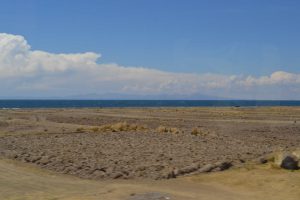
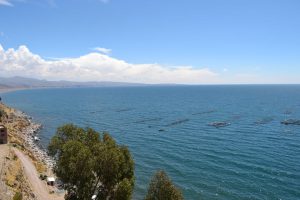
We carried on driving and got to the border at 12.40 and the timer began. It was the strangest border crossing I have ever seen! There was a market running from Peru, straight into Bolivia; it wasn’t just any market though, it was selling all sorts of things – mainly mattresses (which we found strange) and the people were just walking up and down the middle of the road. It was bizarre!
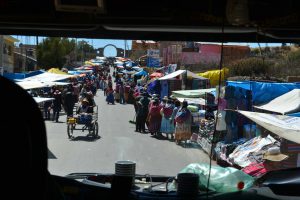
We got off the truck in Peru and we were the only ones going into border control. We went into the office and had our passports stamped to say we were leaving Peru. Once we had all done that, there was a little lady sat outside with money exchange facilities. Rianne got us a deal with her, if we all exchanges our soles with her – I didn’t have many left to exchange but there was no point in me keeping them.
Once we had exchanged our money and we were finished in Peru, we walked up the road (because David had already taken Amber), under the archway and into Bolivia – it was so weird! There wasn’t anyone standing there checking anything, we literally just walked in.
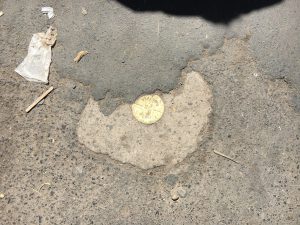
When we were in Bolivia, we then had to go to border control on the Bolivian side to get our entrance stamps – there wasn’t actually anyone telling us to do this and there was nothing stopping us just walking through into Bolivia with no one checking our passports. We filled out our entry forms and got our passports stamped – again, we were the only ones in there, I was so confused by the whole thing!
Sadly for me, we were done in record time and back in the truck in 48 minutes – neither David nor Rianne have experienced this before. This did mean though that I lost the game, but it wasn’t too bad because it was over so quickly. The game wasn’t the only thing I lost; because we had crossed a time border, I also lost an hour as the clocks jumped forward to 2.28 once we were in Bolivia.
We only had to drive about 20 more minutes down the road – once we had got through the busy markets and all the people – until we reached Copacabana. We arrived just before 3 and had a little bit of time to chill before our next briefing.
At 3.30, we met our next local guide, Leo, who was going to take us on a tour of the islands of Lake Titicaca. He gave us a brief overview of the next few days and gave us a few minutes to prepare ourselves before we set off towards the boat at 3.45.
We got onto the boat and had the option to sit on the roof if we wanted – of course I tried it (with some others) but I didn’t last the full length of the journey because it got pretty chilly up there.
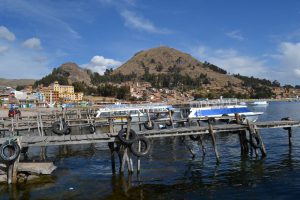
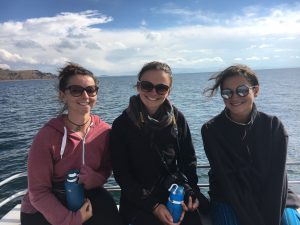
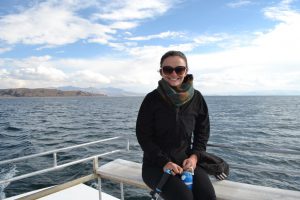
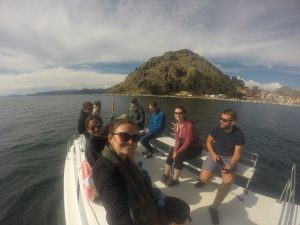
When we went back into the boat, Leo gave us some information about Lake Titicaca, some of which was quite surprising. He told us that the lake is 8300 square kilometres, which I couldn’t get my head around – I always thought I would be able to see the other side of the lake from wherever I stood, but I really couldn’t. It is 3810m above sea level, which I could still feel in my chest – annoying because I had been fine in altitude until I got bit at Machupicchu. Due to be surrounded by mountains, the temperature doesn’t really differ between day and night and there isn’t a huge difference between winter and summer: in winter, it can range from 0 – 20 degrees and in summer between 4 and 25 degrees.
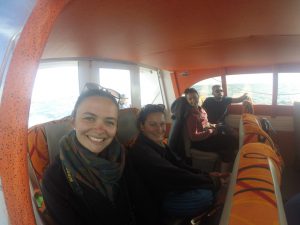
Leo told us that Lake Titicaca was formed by glaciers melting many years ago. The glaciers formed two lakes: Lake Titicaca and Lake Bolva – which disappeared one and a half years ago because of evaporation and people taking advantage of the water too much. Lake Titicaca is split into two separate lakes and we were on the bigger of the two. The Tiquina Straight separates the two lakes.
Although the lake crosses the border of Peru and Bolivia and we visited the Bolivian side, 67% of Lake Titicaca is actually of the Peruvian side. There is a whole algae city underneath the lake but there hasn’t been much research into the algae. This is due to money, but mainly because of the altitude: divers are not allowed to be under the water for more than 40 – 50 minutes a day, because the lake is so high above sea level. We were also told that Lake Titicaca had technically been classed as a salt water lake because there is 1 gram of salt per litre of water; however, this is nothing in comparison to the sea which had 35 grams of salt per litre.
Lake Titicaca is a sacred lake of the Inkas, and we were heading towards Isla del Sol (Sun Island) on the boat, which is a sacred island of the Inkas. There are 72 islands on the lake, but Sun Island is the largest, at over 15km long.
Just over an hour after we left Copacabana, we arrived at Isla del Sol. We only had our day bags with us for the evening, because we had a lot of walked to do apparently, which Rianne did not warn us about. Leo told us that we would be walking some on the Inka trails. He said that there are between 30,000 and 50,000 Inka trails in South America, so whenever people say they walked an Inka trail, they need to be more specific.
As we got off the boat, we looked at some ruins, just by the jetty. Leo said that they weren’t anything special, they would have just been a house, but Sun Island is so important to the Inkas because of the opposite side of the island to where we were, was a sacred stone that the worshiped, which looked like a puma; it is called Titicaca (which is where the lake gets its name – titi meaning puma and caca meaning stone.
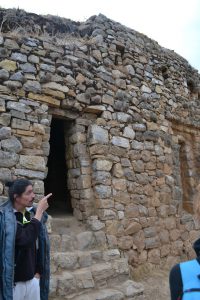
Just as we began our walk to the hostel (which Leo told us would take an hour and a half, a big cloud came over us and it started to rain and then hail – so much for Sun Island. It was so cold to walk in and we had to far to go. Leo said that in the winter (which is dry season) it had rained only 3 times in the last 18 years – we were there for the fourth.
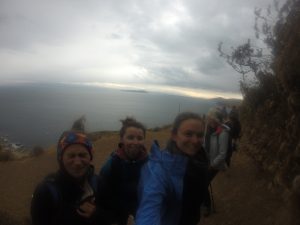
Luckily, we are quicker than average walkers and although I found it really difficult on my breathing going uphill, we were at the hostel in under an hour – we really must be a fast group.
When we got to the hotel, it was still raining and it continued to rain while we had to find our rooms (which were outside from reception), while we sat and chilled, while we went to dinner and all night long. Leo had booked us a place for a group dinner in the village, which was bigger than I expected and I wasn’t really up for exploring in the pouring rain. It wasn’t too far to the restaurant, so we all huddled and ran there together.
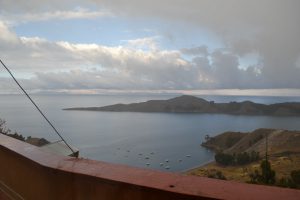
For dinner I had breaded chicken with chips and veggies – it was so nice and unbelievably cheap; for my meal and drink, I paid 50 Bolivianos (£1 is the same as 9 Bolivianos)! The constant rain was making us so cold, so after we ate, we ran (kind of) back to the hostel and went straight to our rooms. I tried to dry off and warm up as quickly as I could before getting into bed.
The rain and storms continued all night but it didn’t keep me awake – I don’t think much could after the hectic couple of weeks I have had.
The alarm went off at 6.45 because we (me and Sabrina) wanted to snooze it a few times before we had to get up and be down for breakfast at 7.30. Once we were up and ready, I wasn’t so tired, but the miserable weather that continued didn’t exactly make me feel happy.
We went down for breakfast, which was bread and jam (of course), with eggs (of course). The rain kept on coming and it occasionally turned into hail – it did not make me look forward to the 10km walk we had ahead of us but Leo kept promising us it would brighten up.
We left the hostel around 8ish and head back down the mountain on the island, towards the jetty – a different jetty to the one we came in on, so it wasn’t too far but it was all downhill which wasn’t good for my knees (they really need a good rest). It did, however, continue to rain and it rained until the moment we stepped onto the boat – typical. From the moment we got off the boat, until the moment we go back on it, all Sun Island did was deliver rain!
We got the boat a short distance across the lake, to Isla de la Luna (Moon Island). It was still gloomy weather when we got to Moon Island, but we weren’t spending very long there (Leo said about 20 minutes); we were just looking at more ruins and then carrying on, on the boat. We walked a short distance to the ruins, but Leo was saying that archaeologists don’t really know much about them, besides the fact that they were rooms. We had a quick look round before getting back on the boat and carrying on.
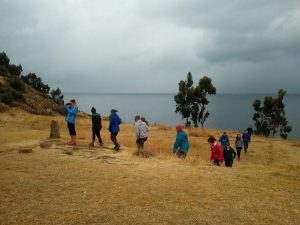
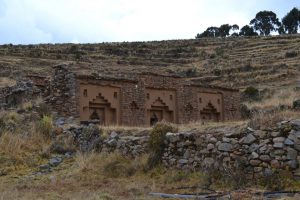
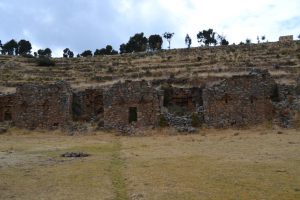
Next, we drove about half an hour more on the boat before we reached the mainland; we didn’t go to Copacabana though. We got off the boat where it had docked and had a 10km walk around the peninsula to where the boat would pick us up again. The sun had finally made an appearance when we got to the mainland too, so that was a nice addition because it wasn’t too hot, but it was dry.
The first hour of the walk was all uphill and although we have done a lot of uphill walks recently, I still struggled. I just had to find my own pace (which was very slow, but I didn’t care) and take it at that. When we reached the top (at around 4000m), we didn’t have much further to go – even though Leo said the whole walk would be 3 – 4 hours. Luckily, once we reached the highest point of the day, the rest of the walk was mainly downhill; it was a gradual downhill too which was nice, as it wasn’t too painful until right near the end when it got steeper.
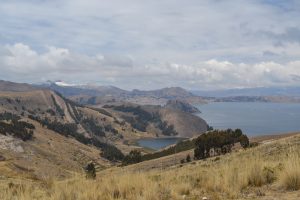
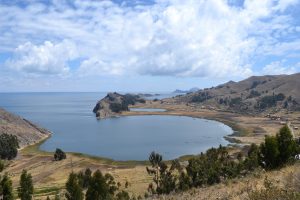
We reached the lunch stop within two hours and this was where we were getting picked up by the boat – so we were done much quicker than Leo thought. We ate our lunch looking over the lake, with some beautiful views.
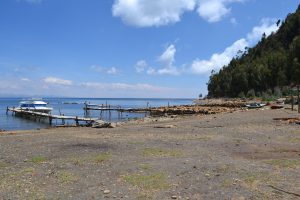
As soon as the sun went in, it became quite cold so some of us decided to get back on the boat. According to Leo, we were about 5km from Copacabana and there was the option to walk back. For once, I didn’t take this option because my knee was sore and I was cold and just wanted to get back and do my own thing.
After a very short 20 minute boat ride, we were back at Copacabana. We got off the boat and had a short walk back to the hotel before we could check in. We checked in and planned to chill in the hotel café for a little while, but the café was shutting just after we got there and as the storm had hit the mainland too and had hit some aerials, cutting out electricity and wifi signal, we decided to go out.
We went for a walk up to the main square, which didn’t really have much to offer and wasn’t really very busy, so we didn’t know what to do. We then decided to find a café to sit in with a drink and cake and just chill out for a while. This became a mission though because nowhere sold cake! We ended up in a café that David had recommended – we had tried it earlier but it was busy with not much left. It was a cute little café and it was still busy, so we ended up just getting a cookie each (which were amazing). While we were sat there, the owner started talking to us (she was American). She was explaining that she was so busy because there are blockades in both Puno and La Paz, so there aren’t really people visiting Copacabana which is in between both places. Due to the blockades and lack of people, most restaurants have decided not to open because it isn’t worth it to buy in the stock and pay the staff if they only get a few customers. However, the tourists that do turn up need somewhere to go which is why they were opened and why they were so busy, because not much else was open.
After our cookie, we decided to find a different café because we have grown a little obsession for freshly made lemonade and the cookie café didn’t have any. We found a café that did and got a jug of lemonade between the three of us (me, Katie and Sabrina). It wasn’t the nicest lemonade we have had, but it was okay and it was very cheap. We sat there for a while before deciding to go back to the hotel.
Back at the hotel, we had a couple of hours to chill before dinner. We showered and I took the time to catch up on things, such as photos and patches.
For dinner, we had already ordered it on the drive over, because we were eating at the café attached to the hotel. We could choose between soup, Thai curry, lasagne or trout. Most people chose the curry but me and Katie chose the lasagne and I think we were better off – lots of people were jealous. We had a passion fruit mousse for dessert which I wasn’t sure about at first, but it was nice.
After dinner, we went up to the room, finished packing and went to sleep. Lay in bed, we could hear the storm returning and the thunder sounded so close – I was just glad we were inside and didn’t have to go out in it.
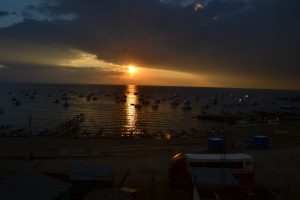
The alarm went off at 7.15 (quite a lie in) because back locker had to be done at 7.45 before breakfast. We got up and ready and took our bags down to Amber (for the last time), before we went to breakfast.
Breakfast was kind of buffet style, with fruit and porridge and eggs and bacon. There was also toasted bread on the table. It was a good breakfast and although I wasn’t feeling 100% because the cold is beginning to take over, I ate enough to keep me going.
We had a little bit of time to chill after breakfast because David had taken the truck to get her fixed again (apparently there was another problem with the brakes). Once she was fixed, he took her up to the main square to get it decorated. At 9.15, we left to go and meet him. We walked up to the centre as a group, where we found David and Amber being decorated all nicely; David and Rianne had decided to change the itinerary slightly for the day because we were meant to be seeing more ruins but because we have seen so many, they decided to get the truck decorated and blessed for our safe journey instead.
When we got there, the Bolivian ladies were putting the final touches onto the front of the truck – David was making sure the decorations went in the right places so that they didn’t ruin the truck paintwork.
We had some time to wander around the square before the blessing began, so we went back to the cookie café from the day before. When we got there, Rianne was coming out with our packed lunches for the day; this made me very happy because I saw how good the food was when we were there and we could smell the food when we entered – apparently they had freshly baked cookies for us that morning! I bought myself an extra treat because I couldn’t resist, so I got a cheesecake brownie, yum!
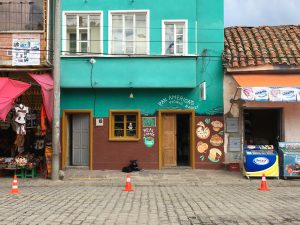
We had to be back at the truck for 10 as that was the time slot we had been given for the blessing. We got back and had some photos in front of Amber looking all beautiful before the priest arrived to bless her.
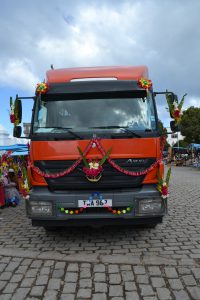
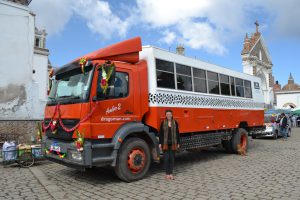
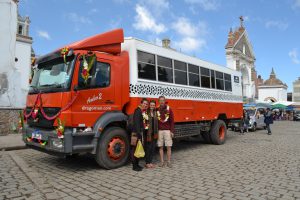
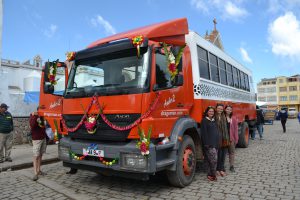
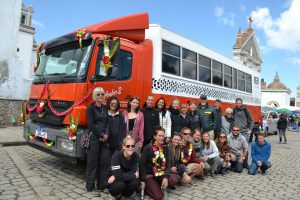
When he arrived, he blessed her for our safe travels (she needed it after breaking down twice in the last week); he blessed her on the outside before going inside too. After he had blessed her, David had been given wine to sprinkle on Amber as an extra blessing and then he had to give Pacha Mama some too. After the wine, we had some firecrackers to let go underneath the truck, which were loud and hurt when they caught my foot. Just before the final part, a Bolivian woman approached and said she would do another blessing on the truck; I’m not convinced she was anything official, but we did need all the luck we could get. Finally, we had some flower petals to throw over Amber as confetti.
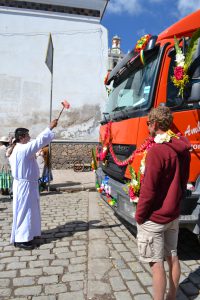
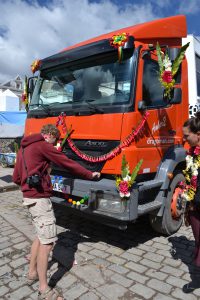
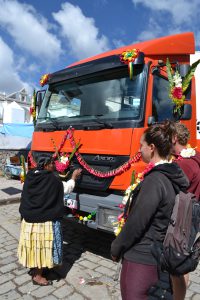
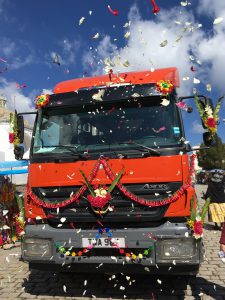
After the blessing ceremony, we all got back on the truck, ready for our final drive of this leg of the trip to La Paz; it was also my final trip in Amber! Despite the rain, Copacabana was a nice stop. It was good to do some walking, even though I was in pain, it was good to see lake Titicaca and ride the boat across it and it was good to have some rest. My favourite part though, was seeing Amber all dressed up just before we left!
To travel is to live, Katie x
One Reply to “Copacabana (Isla del Sol), Bolivia”
End of an era!! 😂😘xx